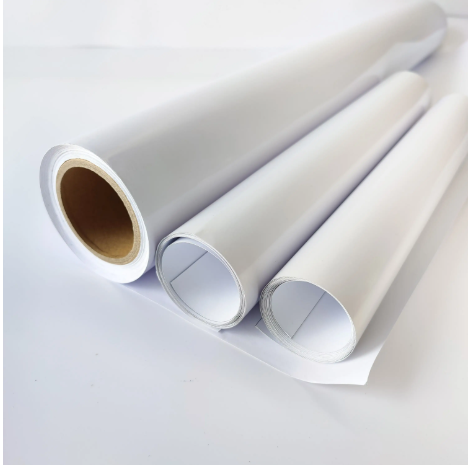How Long Does Self-Adhesive Vinyl Last?
Average Lifespan of Removable vs. Permanent Vinyl
Self adhesive vinyl comes in handy for all sorts of decoration and sign work, and it's usually split into two main categories: stuff that comes off easily and stuff meant to stick around forever. The easy peel variety tends to hold up for about three to five years before starting to lose grip, while the permanent stuff can last closer to seven years without losing much stickiness at all. When picking which kind to use, most people look at how long they want whatever they're putting up to stay there. For things that won't be around forever like seasonal signs or temporary wall art, the removable stuff works great. Permanent vinyl makes more sense for those bigger projects that need to stick around for years. But watch out for Mother Nature! Both kinds struggle when exposed to really bad weather over time. Heat waves, high humidity, and constant sun exposure will wear them down faster than expected, so location matters quite a bit when planning installation.
Looking at what manufacturers have to say about their products gives a much better idea of how long things might last. Companies such as Oracal and Avery really stand out in this space, they've built their reputations on providing thorough information about how their materials perform under different conditions. Their specs sheets often include real world testing results that give customers something concrete to go on when making choices. Getting familiar with all this info helps determine which kind of vinyl works best for specific projects, and also means the material is likely to stick around longer than expected without failing prematurely.
Key Signs It's Time for Replacement
Knowing when to replace self adhesive vinyl depends on spotting the warning signs of wear and tear. The most obvious problem tends to be fading colors or strange discoloration spots, usually because the material has been sitting out in sunlight for too long. When this happens, it looks bad obviously, but there's another issue going on beneath the surface too the glue holding everything together starts losing its grip. Edges start to curl up or lift away from whatever surface they're stuck to, which means the bond between the vinyl and the wall (or wherever it's applied) isn't as strong anymore. Once that happens, dust and water find their way underneath, making the whole thing look worse over time while also shortening how long the vinyl will actually stay put.
Scratches and tears on vinyl are clear signs that it's time for a new piece. These kinds of damages do more than just look bad they actually point to the fact that replacement should happen sooner rather than later if we want to keep things looking good. Checking vinyl surfaces regularly for these problems helps maintain both how they work and how they look. This kind of maintenance extends their lifespan significantly and cuts down on having to buy new materials all the time. A little attention goes a long way when it comes to keeping vinyl in top condition.
Factors Affecting Self-Adhesive Vinyl Durability
Surface Preparation and Application Quality
How long self adhesive vinyl lasts really comes down to how well the surface was prepped and how carefully it gets applied. For best results, always put the vinyl on a spot that's totally clean without any dust or dirt particles. Most pros will tell anyone who asks that a clean surface makes all the difference because otherwise the glue just can't stick properly over time. When applying, take care to work out those pesky air bubbles too since they weaken the bond between the vinyl and whatever surface it's going on. Installers swear by using something like a plastic squeegee while putting it down. This helps press everything together tightly so the vinyl stays put for much longer periods without peeling off.
Environmental Impacts (Humidity, UV Exposure)
The durability of self adhesive vinyl really depends on where it gets installed. When humidity levels rise, the glue holding everything together starts to lose strength, which means the vinyl might start shrinking at the edges or curling up from the surface over time. Sunlight is another big problem for vinyl materials. Prolonged exposure to UV rays breaks down the chemical structure, making colors fade away and the material itself turn brittle and prone to cracking. That's why experienced installers often reach for specially formulated UV resistant vinyl when working on exterior projects. Some field tests show that outdoor vinyl tends to break down about half as fast compared to what happens inside climate controlled spaces. So when picking out materials for any application, considering how much sun and moisture they'll face makes all the difference in keeping things looking good and functioning properly for years to come.
Vinyl Quality and Adhesive Strength
Vinyl quality matters a lot when we talk about how well something holds up over time, especially those sticky properties that keep things attached properly. The better stuff coming from established brands tends to last longer too, standing up against weather changes and other harsh conditions much better than cheaper alternatives. When looking at different kinds of vinyl on the market, there's actually quite a range out there. Some are made specifically for indoor use where they don't need super strong adhesion, while others are built tough enough for outdoor installations that face constant exposure. Industry reports suggest that folks paying extra dollars for top shelf vinyl generally get what they pay for in terms of lifespan and ability to withstand whatever Mother Nature throws at them. For anyone serious about getting good results from their project, spending a bit more upfront on quality materials usually pays off handsomely down the road.
How to Remove Self-Adhesive Vinyl Safely
Heat Application Techniques (Hairdryer, Heat Gun)
Heat works wonders for getting rid of those stubborn self-stick vinyls without wrecking what's underneath. When we talk about actual removal, most folks grab either a hair dryer or heat gun and start warming up that sticker. As the glue gets warm, it starts to lose its grip, so peeling becomes much less painful than trying to rip it cold. Just don't get too close though - I've seen plenty of people burn their walls by holding the tool right against the surface. The manufacturers usually put some basic directions in their packaging, but honestly the best advice comes from watching YouTube clips where real people show exactly how far away to hold the heat source and what temperature settings work best for different materials.
Chemical Solutions: Goo Gone vs. Rubbing Alcohol
When trying to pick between chemical options such as Goo Gone versus rubbing alcohol for getting rid of vinyl stuff, it really helps compare what each does best. Goo Gone was made specifically for breaking down sticky residues, while regular rubbing alcohol sits around most homes already. People want to be careful when using either one though. Read those labels properly before applying anything liberally all over something valuable. Start by testing on just a tiny spot somewhere nobody notices if at all possible. That way we don't end up ruining whatever surface we're working on.
Avoiding Damage to Underlying Surfaces
Most people really care about not damaging surfaces when taking off vinyl stickers or decals. Going with plastic scrapers rather than metal ones makes all the difference in preventing those annoying scratches and deep gouges. Wood surfaces versus painted walls will behave completely differently during the removal process so knowing what kind of material we're dealing with matters quite a bit. A lot of folks find themselves turning to online guides these days because they want to avoid costly errors. These resources usually contain practical advice on how to get rid of stubborn adhesive without leaving behind any ugly residue or causing permanent damage to whatever surface they're working on.
Step-by-Step Guide to Replacing Vinyl
Cleaning Residue and Prepping the Surface
Getting the surface ready right matters a lot when it comes to making sure vinyl sticks properly. Start off by getting rid of old glue residue first. Products like Goo Gone work well or just grab some rubbing alcohol from the drugstore. Scrub until nothing sticky remains and the area feels nice and smooth to touch. Once that's done, give the spot another wipe down with alcohol solution. This helps create a really clean foundation so the new vinyl will bond better. Don't rush things though. Let everything dry completely before putting on fresh vinyl material. Rushing can lead to problems later on like bubbles forming under the edges or sections coming loose over time.
Choosing the Right Replacement Vinyl
Picking out replacement vinyl isn't something to rush into without thinking about what really matters for the job at hand. When shopping around, think first about how long the material needs to last, what colors work best for the space, and whether the finish should be glossy or matte depending on where it goes. Some areas get hit hard by sun exposure while others deal with constant moisture, so finding brands that stand up to these conditions makes all the difference. People who know their stuff usually recommend checking online reviews from real users and maybe even talking to someone who works in the field before making a final decision. After all, nobody wants to spend money on cheap vinyl that looks great now but falls apart after just a few months of use.
Tips for Seamless Reapplication
Getting that pro finish when putting on new vinyl takes paying close attention to every little detail. Start off by matching up the new material with what's already there, making sure those patterns line up just right so it looks continuous instead of patchy. To get rid of those annoying air bubbles, grab a squeegee and work from the middle outward. This helps push out trapped air before it becomes a problem. After everything is down, take some time to check things over properly. Make sure the vinyl sticks well without any gaps or wrinkles showing through. Look for spots where it might not be lying flat against the surface. A good job now means less hassle later on, and the vinyl will stay looking nice for much longer without peeling away or developing ugly bubbles.
FAQ
How long can self-adhesive vinyl last?
Removable self-adhesive vinyl typically lasts 3 to 5 years, while permanent vinyl can last up to 7 years.
What are the factors that affect vinyl's lifespan?
Environmental conditions, surface preparation, quality of vinyl, and adhesive strength affect the longevity of self-adhesive vinyl.
How can I safely remove self-adhesive vinyl?
Use heat application techniques or chemical solutions like Goo Gone or rubbing alcohol, ensuring minimal surface damage.

